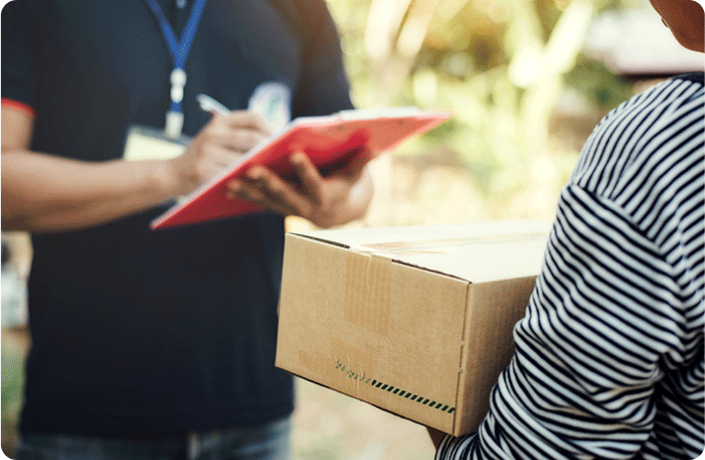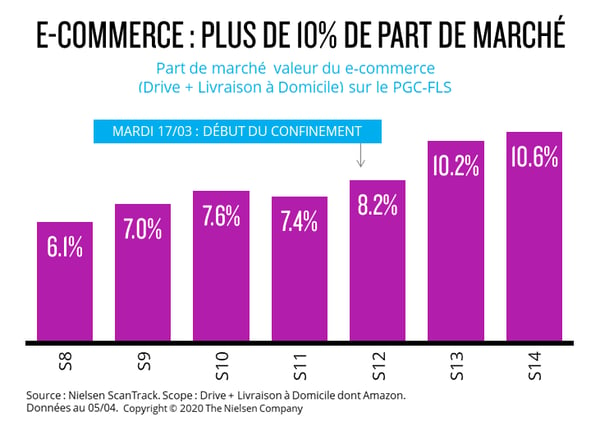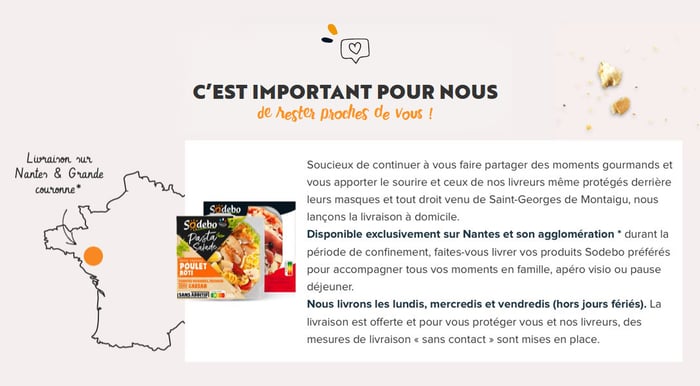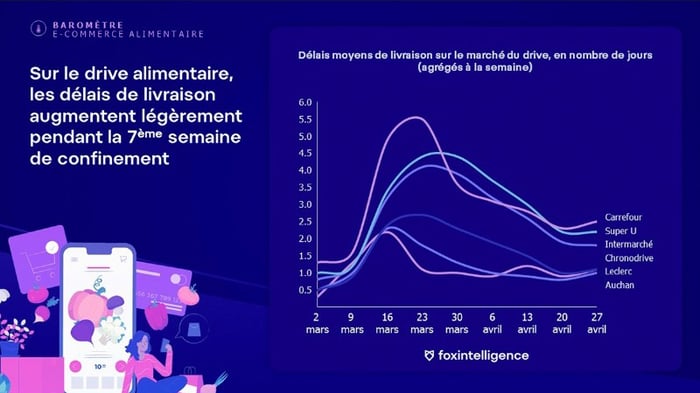The trials and tribulations of home delivery in a time of crisis

Health measures introduced over the last twelve weeks have had a huge impact on consumer buying habits. Will these changes last? It’s still too early to say. Rather than drawing any hasty conclusions, we thought it might be useful to take a step back and look at what has been going on during lockdown, and how home delivery has played a central – even vital – role for both consumers and those working in retail.
The boom in online grocery shopping
Barely allowed to leave home and with no idea of how long the lockdown would last, nor any real understanding of how the crisis was going to affect their purchasing power in the medium to long term, the French have limited their shopping to the basic essentials: food, hygiene and household care products. Many have favoured shopping locally, and many others have resorted to buying online, especially via the websites of the major supermarket chains.
- Kantar estimates that online retail has signed up 2.5 million new customers since the first week of lockdown, a significant proportion of them being seniors (500,000 according to Nielsen) who’d never before ordered anything online.
- Online sales exceeded 10% of the fast moving consumer goods segment during the lockdown, compared to an annual average of 5.7% in 2019 (Nielsen)

Legend:
E-commerce – more than 10% of market share.
Market share value of e-commerce (Click-and-collect and home delivery) of fast moving consumer goods
Tuesday, 17 March START OF LOCKDOWN
General increase in the demand for home delivery
In the light of the health risks and restrictions on movement, the home delivery or click-and-collect options that allow consumers to shop at their habitual supermarkets have clearly been pivotal for both new online shoppers and seasoned customers alike. As a result, supermarket chains have had to deal with a surge of online orders in a very short space of time. This has not all been plain sailing… In order to manage the high number of visits to its website at peak time and to prevent customers from giving up, Casino had to introduce a virtual queue to show the waiting time before reaching the “shopping basket” page.
Whatever the details of the case, the fact that shoppers have turned to the supermarket chains’ online sales has meant the latter have been able to offset the drop in customers visiting their shops. Even more so as the closure of cafes and restaurants and the need for families to produce 2 meals a day has led to an 89% increase in the average shopping basket value (IRI via Le Point).
Whilst click-and-collect has been the overall winner of the lockdown, having captured up to 80% of the growth in general online retail (Nielsen), home delivery of groceries has also boomed. For example:.
- Stuart – a company that delivers to homes in 80 towns on behalf of Carrefour, Franprix, Monoprix, Naturalia, Auchan and even Bio C’bon – has had to manage a threefold increase in orders since the start of the lockdown.
- Alternative local food suppliers, such as La ruche qui dit oui, or even producers’ own platforms, have also seen the demand for home delivery of their fresh products double since the closure of their normal outlets.
- To satisfy demand, some chains have turned to home delivery platforms such as Uber-Eats (Carrefour and Casino) and Deliveroo (Monop’ and Franprix) for standardised baskets and a limited range of single unit products.
- To put the brakes on the decline in their activity, some in the agrifood sector have decided to create their own home delivery service, for example Sodebo in the Nantes region.

The tricky business of home delivery slots
The sudden increase in demand has meant that all food retailers have struggled to adapt and this has had a negative impact on delivery times and customer satisfaction.
- The preparation of orders has been slowed down by a lack of staff and because of social distancing measures put in place in warehouses/shops to ensure workers’ safety. It’s also been complicated by the persistent unavailability of certain items and the difficulty in finding replacement products.
- Delivery timescales have become considerably longer. In the first weeks, click-and-collect service and home delivery times rose to up to 3 days (up to 5.5 for click-and-collect according to the Foxintelligence barometer) something which didn’t stop all the available slots from being snapped up immediately. Monoprix reported that “What we noticed was that slots would remain available for all of about 5 seconds on our online shop”.
- Solutions found are not always ideal… Some supermarket chains have been forced intermittently to suspend accepting online orders and their delivery service in order to honour the orders already placed to catch-up. Houra.fr (an online affiliate of Cora) for example, has adopted a solution which follows the delivery calendar for the next 7 days in real time and for every postcode serviced by the website. The ability to place an order is automatically stopped when all the slots in a particular postcode have been taken, and is then re-established when new slots become available.

Legend:
On the left side: For click-and-collect, delivery times increase slightly in the 7th week of lockdown.
Chart: average delivery time for the click-and-collect market, in number of days (aggregated by week)
In our opinion, using postcodes is not the most effective way to organise delivery rounds at peak times. The supermarket may have increased its delivery capacity by relying on geo-tracking of customer’s addresses. They may, in this way, have been able to create more densely packed delivery routes where the physical distance between the addresses rather than their adherence to an administrative area is prioritised. This would change delivery drivers’ habits of course, and increase the number of kilometres travelled. However, taking into account 1) the exceptional traffic fluidity during lockdown and 2) the almost guaranteed presence of customers at home, drivers would have benefited from being able to deliver to more customers in one round.
The key to optimisation in a time of crisis is to be able to quickly change the parameters used under normal circumstances for calculating delivery rounds – quite simply because the priorities, the resources available and the operational conditions change. This is precisely what NOMADIA’s optimisation solutions enable retailers and their logistics partners to achieve.
Besides groceries, more free deliveries but with longer delivery times…
Delivery delays have not only affected food retail. All online merchants (pure players or not) as well as their logistics providers have seen an increase in delivery times since the the start of lockdown and despite a very slight decline in sales. This can be explained by the closure of ‘non-essential’ shops which usually serve as a collection point (Mondial Relay and Relais Colis) and click-and-collect, for those brands built on a physical network.
Creating a home delivery service has been the only way that all these sites have survived. However, this has overwhelmed providers who have found themselves obliged to adopt stringent health measures, and has led to delays and the suspension of the normal guarantees on iconic offers such as Colissimo and Chronopost.
Research undertaken by Fevad between the 23 and 25 March 2020 on 136 online sales sites in France reveals disruption in the logistics chain from warehouses to service provider. The consequences of this are:
- 85% of sites have increased delivery times;
- 1 in 3 sites offers free or reduced cost for home delivery – an expensive measure designed to compensate for the free delivery or discounted price at click-and-collect points which always attracts more customers;
- The majority of sites have extended the window for cancellation and extended the window for product returns to 30 or even 60 days, instead of the 14 days under normal conditions, in order to take into account the restrictions on movement.
A second study by Fevad carried out at the end of April revealed that 41% of the sites surveyed had seen an improvement in the situation in warehouses, but 36.5% highlighted that conditions and delivery times were worsening whilst their activity started to increase.
And now, what lies ahead?
The lockdown is coming to an end but the return to normal will take a long time – and all the more because at the end of the health crisis looms an economic one which all observers have already labelled as ‘major’. Will the French return to the high street and spend the 55 to 60 billion that they’ve been forced to save during the lockdown? Have they got used to consuming less? Will those who’ve discovered the comfort of shopping online and ease of home delivery abandon shopping in superstores forever? Will those who’ve turned to alternative food sources stay faithful to their new suppliers? Are they willing to accept delivery times of up to a few days rather than the 24 hours maximum that was the norm before the crisis?
If you can answer that one, you must be a genius!
In an interview with Le Figaro, Philippe Moatti, economist and co-president of l’Observatoire société et consommation (Obsoco), the French observatory of society and consumption, predicts that “the trends which are most likely to last are those which have been reinforced by the context of the health crisis, notably ecological ideology which had already gained momentum well before the lockdown. For a fraction of the population, the lockdown has provided the stimulus to take the journey further: put consumption back in its place, consume less but better and more intelligently.”
Even if this only involves a “fraction of the population”, this last phrase bodes well. For retail and logistics, it presents challenges that we at Nomadia are perfectly positioned and well-equipped to help our customers overcome.
